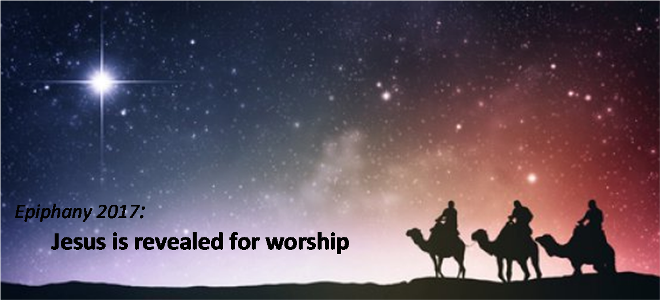 The likely-Jewish shepherds to whom angels announced Jesus’s birth came to see the baby Who was God in human flesh, but the Divinely-inspired St. Luke does not tell us that they worshiped Him (Luke 2:15-20). The likely-Gentile magi who followed a miraculous star in contrast came to worship Him Who had been born King of the Jews (Matthew 2:1-12). The season of Epiphany begins by the day of Epiphany’s marking their coming as a revelation of Jesus as Lord resulting in their worship, continues with other such showings forth, and ends with the greatest example of Jesus revealing His divine nature, the Transfiguration. In each the case of each observance during the Epiphany season, the Gospel Readings enable and call for a response from us to whom Jesus is thereby revealed.
The likely-Jewish shepherds to whom angels announced Jesus’s birth came to see the baby Who was God in human flesh, but the Divinely-inspired St. Luke does not tell us that they worshiped Him (Luke 2:15-20). The likely-Gentile magi who followed a miraculous star in contrast came to worship Him Who had been born King of the Jews (Matthew 2:1-12). The season of Epiphany begins by the day of Epiphany’s marking their coming as a revelation of Jesus as Lord resulting in their worship, continues with other such showings forth, and ends with the greatest example of Jesus revealing His divine nature, the Transfiguration. In each the case of each observance during the Epiphany season, the Gospel Readings enable and call for a response from us to whom Jesus is thereby revealed.
The day of Epiphany itself, January 6th, is sometimes called “Gentiles’ Christmas”, as the magi brought three gifts to the boy Jesus. Pilgrim again this year offers a special Divine Service at 7:00 p.m. on the day of Epiphany, when we worship the crucified and resurrected man Jesus by seeking and receiving the forgiveness of sins He won for us on the cross. All are invited and welcome to attend.
The First Sunday after Epiphany (January 7th, this year) commemorates The Baptism of Our Lord (Mark 1:4-11). That event is one of the clearest revelations of our Triune God as Father (the voice from heaven), Son (the man Jesus standing in the Jordan River), and Holy Spirit (the dove). And, in being baptized, Jesus sets apart as holy such a washing for our forgiveness of sins. We do not witness the epiphany of the Trinity as did those present there that day, but we have our own epiphanies, as it were, in our baptisms, which connect us to Jesus’s death and resurrection (Romans 6:1-14), and thereby give those who believe the forgiveness of sins and so also eternal life.
The Epiphany season begins and ends with the church using the color white, appropriate for baptism and the light and purity of our Lord, but for the Sundays in between the church uses green, the color of growth, leaves, foliage, fruit, and life, suggesting spiritual growth. Such spiritual growth comes about by the pure preaching of the Gospel and right administration of the Sacraments. As God wills, such spiritual growth also can be accompanied by numerical growth, as He creates faith when and where He pleases in those who hear the Gospel.
The following are the “green” Sundays in Epiphany 2018 and their Gospel Readings (appointed by Lutheran Service Book’s three-year lectionary series B, which largely uses the Holy Gospel according to St. Mark).
- Second Sunday after the Epiphany (1/14): Jesus calls two disciples (John 1:43-51)
- Third Sunday after the Epiphany (1/21): Jesus preaches and calls more disciples (Mark 1:14-20)
- Fourth Sunday after the Epiphany (1/28): Jesus teaches with authority (Mark 1:21-28)
- Fifth Sunday after the Epiphany (2/4): Jesus heals and casts out demons (Mark 1:29-39)
No matter how many Sundays there are in Epiphany, in Lutheran practice dating back to the Reformation, the last Sunday is always The Transfiguration of our Lord (February 11th, this year). The Transfiguration is the greatest showing forth of Jesus as Lord, right before He sets out in earnest to die on the cross for all people’s sins (Mark 9:2-9).
You are always welcome at Pilgrim in person, but even here online you can read and hear the sermons at Pilgrim from the Season of Epiphany and from every season of the Church Year.
The banner graphic at the top of this page and the corresponding slider graphic uses an image found uncredited here.

